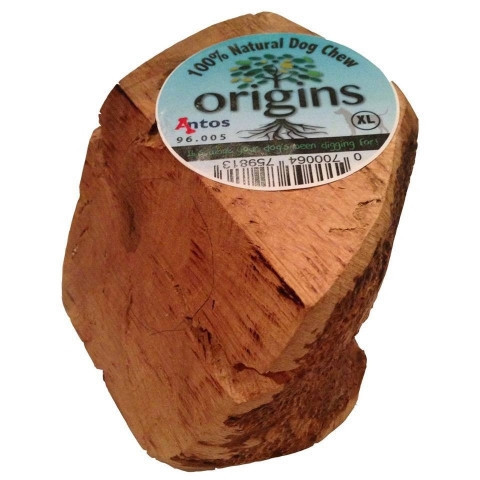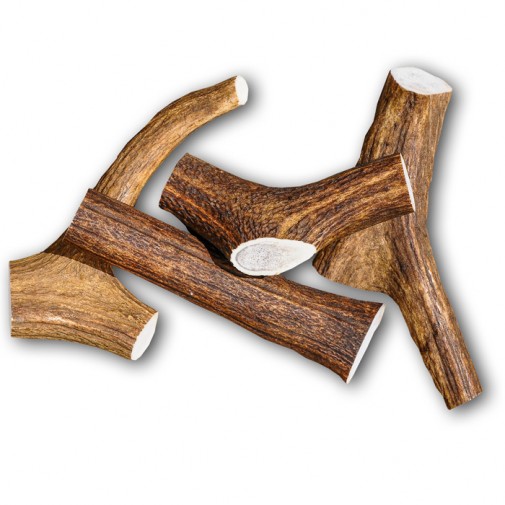Chewing is a natural behaviour all dogs need to express. They are designed to gnaw and chew only for dental health reasons but also for psychological needs. Chewing and gnawing is a natural de-stressor for dogs and for this reason should be encouraged. BUT they should be encouraged to chew dog safe products.
Every dog is different and a treat or toy that’s good for one dog to chew may nt be suitable for another. This is because every dog chews differently. Some will bear down on the chew, trying to break off chunks, others will work away gently mouthing the toy or treat. It is important to choose the most appropriate chew for your individual dog.
Chewing is an instinctive behavior for all dogs. It develops the powerful neck and jaw muscles that wild canines must have to capture and kill their prey. It also removes plaque, keeps teeth and gums clean, provides mental stimulation and relieves boredom and frustration. Watching a dog in a state of blissful chewing pleasure shows how important it is to his wellbeing. Some dogs have far stronger chew drives than others, and power chewers need safe, long-lasting chews to avoid destructive behaviors. Other dogs seem to lose the urge when they mature, or only like to chew on a few favorite things. Whatever your dog’s level of interest, there’s a recreational chew suited to his needs.
Chewing Hints and Tips
- Learn how your dog chews. Everydog is different and what is suitable for one may not be for another. Some dogs are known strong chewers, this is when they bear down and tear at the chew with strong jaws. If this sounds like your pet, look for chews meant to be easily digested, or for hard chews that won’t splinter, fracture or tear to encourage proper gnawing behaviours.
- Watch your dog or puppy the first time they get anything new to chew. If they can tear at the chew and remove chunks easily or looks as though they are going through it in record time it is best to take the treat away from them. This indicates that the chew is not for them.
- They should – gnaw at the ends of the chew, gradually wearing it down.
- Match the size of the treat to the size of the dog. A dog needs to be able to pick up the chew, get their jaw around it and hold it between their paws. All dogs need chews that are big enough for them to enjoy and gnaw on without the risk of swallowing them whole. Never give a dog something they can fully fit whole in their mouth.
- Watch your pet carefully, no matter how they prefer to chew their toys or chews, it’s important that it is taken away when it becomes too small. Good chews are designed to worn down over time through gnawing, but they will still wear away. When they get to size that the dog can fit the whole thing in their mouth it is best to take it away to reduce the risk of them swallowing it whole.
Types of Chews
There are loads of chews available in our stores, here we’ve got some of our favourites to give you some ideas, but pop in to your local store to see our full range of gnawing goodness.

Orijen Root Chews
The origin root chew from Antos is a super long lasting natural dog chew and is the tuber root of a Mediterranean Heath. The root chews are full of nutrients and come from a sustainable source, making them eco-friendly. They are gently harvested, then air dried for several months before being cleaned and cut to size.
Long lasting Non-splintering 100% Natural Suitable for all dogs including puppies (some small furries may even enjoy a gnaw) Satisfy the natural urge to chew Low fat and do not contain any artificial additives or preservatives. The origin chews are all interestingly different because they are naturally grown they come in various knobbly shapes, making each one unique for your pet to enjoy.

Antlers
Antlers are long lasting chews. They wear away when chewed and antlers don’t splinter (as readily as bones), which makes them a much safer option. Antlers are available in five sizes (small, medium, large, extra-large and… jumbo!) also are also available in “Lazy Dog” style; cut in half long-ways for the more laid back dog to get at the bit in the middle, these “lazy” ones are also fab for puppies who are teething as they are much softer. For an added bonus, you could try storing your antlers in your dog’s dry feed bin to make it taste and smell amazing.
Please note: Caution should be taken with Antlers as they are not suitable for powerful chewers or those with dental issues.
We recommend: Antos Antlers.
Buffalo Horns
The Buffalo Horn is a 100% natural horn dog chew. Buffalo Horns last a long time. They wear down slowly with the grinding action on the dog’s teeth and saliva into tasty morsels. Dogs who are losing weight can enjoy Buffalo Horns because they are low in fat and high in protein. Effectively they are ‘raw’, thus retaining all their goodness and contain no additives or preservatives.
Buffalo Horns are incredibly long-lasting so you may find that your dog leaves the chew and goes back to it many times before it’s finished.
Please Note – Dogs must always be supervised when chewing the Buffalo Horn as they should gnaw at it, not bear down. Bearing down can result in the chew splitting or breaking. These chews are not suitable for puppies, dogs with existing dental issues or elderly dogs.
Raw bones – Nature’s best chews
For millennia, dogs have been chewing on raw bones for both nutrition and recreation. The hard weight-bearing leg bones from beef can be cut into marrow bones and knuckle bones for your dog’s gnawing pleasure. When they’ve eaten or stripped off all the nutritious marrow, cartilage, connective tissue, tendons and ligaments, you can throw the rest away. Raw kneecapsare another great recreational chew, and soft enough to be consumed completely. If your dog is new to raw bones, start him slowly to avoid digestive upset. His highly acidic stomach will neutralize any pathogens, but humans should exercise the same cautions as for other raw meat when handling. We don’t recommend softer raw bones such as lamb, pork or poultry for recreational chewing, as they are not hard enough to withstand the jaw strength of most dogs, but young poultry parts have a different role as meal replacement bones.
Puppies love to chew
Puppies chew to relieve the discomfort of teething when their adult teeth are coming in, from 3 to 8 months of age. They also use their mouths to explore the world around them, and will chew on almost anything. Give them lots of different textures and kinds of chews, keeping extras on hand to substitute when they pick up a forbidden object. Frozen bones or rope toys soaked in water and frozen provide cooling relief for teething.
Best options for aggressive chewers
The hardest and longest lasting chews are antlers and slow-cured, thick-walled beef femurs and knuckles. While cooked bones should be avoided, slow curing does not dry out the bones or cause them to splinter in the same way. Dogs will scrape away at them with their teeth and ingest the mineral-laden scrapings. Deer antlers are quite dense and hard, while elk antlers are slightly softer and spongier on the inside. Split elk antlers allow dogs to get at the fragrant marrow-like interior. If the antlers dry out and lose their flavor, soaking in chicken broth or smearing on a little canned food or coconut oil can renew their appeal.
Digestible body part chews
Tendons and other body parts make excellent high-protein, low-fat treats that a dog can completely digest. Most popular are the long-lasting bully sticks in many shapes and sizes, followed by numerous other tendons, tracheas, gullets, tripe and miscellaneous body parts. Tracheas and gullets are especially full of joint-building cartilage, and can be helpful for seniors and arthritis-prone breeds. Dogs who are sensitive to beef have lamb, venison or pork choices in various body parts. There are even fish skin chews, a hard yak cheese chew and dried sweet potato chews that can help control your dog’s gas and firm up his stool.
Chewing safety
Always supervise your dog’s chewing activities, especially if they are strong and persistent chewers. Choking is the main hazard, so choose chews that are on the large size, too large to swallow whole. Be vigilant to ensure your dog isn’t breaking off large pieces that could be swallowed and get stuck in the throat, and take away anything chewed down to a nub. Older dogs may still have a strong drive, and as teeth become more brittle with age, a softer chew might prevent a broken tooth. A few dogs are “gulpers”, indiscriminately grabbing and swallowing toys, socks or whatever they find, and need to be monitored closely because indigestible items can result in an intestinal blockage. Fortunately, most dogs who love to chew do so without any harmful consequences.
CHEWING GUIDE | |
*** FOR THE MOST AGGRESSIVE CHEWERS WITH HEALTHY TEETH | |
SLOW-SMOKED MARROW AND KNUCKLE BONES |
|
RAW BEEF MARROW BONES |
|
YAK CHEESE CHEWS |
|
DEER ANTLERS |
|
** FOR MODERATELY AGGRESSIVE CHEWERS | |
BULLY STICKS (PIZZLES) |
|
RAW BEEF KNUCKLE BONES
|
|
* FOR LESS AGGRESSIVE CHEWERS | |
DIGESTIBLE BODY PARTS
| |
“NO HIDE” CHEWS
|
|
